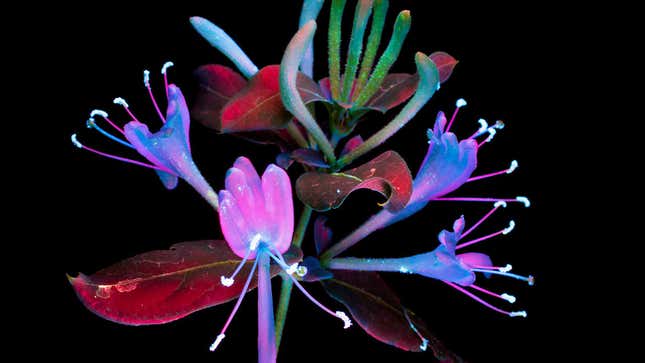
Packed alongside supplies and equipment bound for the International Space Station on an otherwise routine SpaceX resupply run, something rather special is headed to orbit next week: a refrigerator-sized instrument that’ll measure the glow of Earth’s plant life.
That instrument, dubbed Orbiting Carbon Observatory-3 (OCO-3 for short), will study how carbon dioxide levels in our atmosphere fluctuate across space and time—critical information at a time when humanity’s fossil fuel addiction has pushed levels of the greenhouse gas to their highest point in millions of years. But one of the instruments OCO-3 uses to help it measure carbon is going to have a side gig. It’ll also be looking at “solar-induced fluorescence” or SIF, light that plants emit just beyond the range of human eyesight as they’re sucking CO2 out of the sky and using energy from sunlight to convert it into sugar via photosynthesis. (To get a better visual sense of fluorescence, check out this photographer’s amazing work.)
This faint glow gives scientists a way to see, from orbit, where plants are thriving and how they’re responding to a changing climate. While it isn’t a new capability for NASA per se, OCO-3 will, for the first time, be able to measure how plant photosynthesis varies over the course of a day across the tropical forests of South America, Africa, and southeast Asia, some of the most important carbon storehouses on the planet.
As the name suggests, OCO-3 is a sequel to OCO-2, a satellite mission that launched in 2014. During its four-and-a-half years of action, OCO-2 has provided a steadfast record of CO2 and yielded important insights into how plants drive Earth’s carbon cycle. For instance, data from the mission helped scientists discover that 2015-2016 El Niño, which drove temperatures higher and altered global rainfall patterns, caused the tropics to leak an extra 2.5 billion tons of carbon into the air, thanks in part to reduced photosynthesis in the Amazon basin.
OCO-3, which was assembled using spare spectrometers left over from OCO-2, will push this line of research much further. As Nick Parazoo, lead SIF scientist for OCO-3 explained to Earther, the instrument’s perch on the space station—which circles the Earth’s midsection, from 52 degrees north to 52 degrees south—will allow it to take more measurements of the tropics than the polar-orbiting OCO-2 satellite can.
What’s more, while OCO-2 only sees a snapshot in time by zooming over the same places at the same time each day, OCO-3 will capture plant fluorescence and CO2 levels over the course of the entire day.
“OCO-3 observes that same location a little earlier each day, so it’ll span all sunlit hours [in a given location] in about a month,” Parazoo said in a phone interview. This should help scientists tease out when plants are most active and how everything from sunlight to weather conditions influences their growth, information that can help inform land management practices.

OCO-3 also features a novel pointing system that allows it to create snapshot maps of carbon dioxide and plant growth in particular spots on the planet, something that’s never been done from space before. These will allow researchers to start to answering questions like how carbon emissions spread outward from a power plant, how rates of plant growth vary inside and outside the boundaries of a city, and whether volcanic carbon emissions give the local vegetation a boost.
These finer-grained details of the carbon puzzle are where OCO-3 project scientist Annmarie Eldering really hopes the mission can add new insight.
“My goal for where we’ll be in the next three years [is], can we quantify the impact of some subtler changes,” Eldering told Earther in a phone interview. “We’ve had heat waves and droughts in the U.S. that aren’t El Nino scale but still impact crops, et cetera. Can we find out how those phenomena are changing the carbon cycle?”
The mission will join two other plant-focused satellites on the space station: ECOSTRESS, which takes the temperature of leaves as an indicator of plant health and water stress, and GEDI, which launched last fall to create a 3D map of Earth’s forests that essentially allows scientists to weigh them. Altogether, as Parazoo put it, these missions “tell us how plants respond to climate from the tropics up to the boreal forest.”

This trifecta of plant-monitoring prowess almost didn’t happen, though. The Trump administration, which has made no secret of its hostility toward climate science, has repeatedly tried to axe OCO-3 along with other NASA Earth science endeavors, zeroing out funding in both its 2017 and 2018 budgets. Congress, however, has steadfastly added the money back, allowing the carbon monitoring mission to press forward for now.
To Eldering, who has worked at NASA for decades, this sort of political drama is nothing new. “This is not the only mission I’ve worked at that’s had funding go up and away, up and away,” she said.
She’s just glad OCO-3 will have the opportunity to prove that keeping our eyes open to our changing planet is better than flying blind.